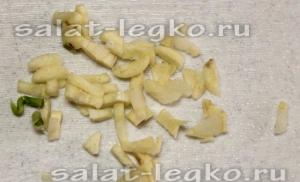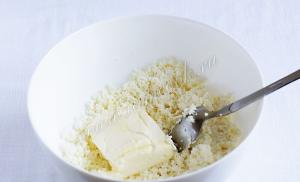Technology of production of succinic acid. Succinic acid
Physico-chemical properties.
Gross formula: C 4 H 6 O 4.
Structural formula:
H O O O O H
Appearance - colorless monoclinic crystals. Melting point 183°C. Decomposition temperature 235°C. Decomposes into succinic anhydride and water. Density 1.563 g/cm3.
Succinic acid is found in human blood and tissues. Concentration succinic acid in blood plasma is 0.04 mmol/dm 3, and in tissues 0.2-0.8 mmol/kg. Succinic acid in organs and tissues is a participant in the cycle tricarboxylic acids Krebs cycle: synthesis of hemoglobin, protein, glycogen synthesis in the liver, glucose absorption. Contraindications: kidney disease, ulcers during exacerbation ( duodenum, stomach).
Application.
Succinic acid is used as a biologically active substance, as well as in the synthesis of various polyester compounds.

Succinic acid is used in plant protection as a growth regulator and stress adaptogen, and also takes part in the cellular respiration of aerobic organisms and helps increase the chlorophyll content. The use of preparations based on succinic acid stabilizes the vital activity of natural soil microflora and ensures intensive biological processing of minerals.
Seeds are treated with succinic acid before planting. This increases germination, growth and yield.
Foliar double treatment of seedlings with a solution of succinic acid from 1 to 10 mg/l increases the survival rate of plants by approximately 10%. Treated plants are 4÷6.5 cm taller.
Succinic acid is used for cut flowers to increase their durability.
Succinic acid is a component of the drug for the treatment of barley smut.
The use of succinic acid in poultry farming, livestock farming and fur farming.
Succinic acid improves the body's adaptation to stressful situations. Such situations may be: a change in the temperature of the environment, a transition to another food, illness, the breeding season, pregnancy, feeding offspring, etc. Prolonged stressful situations are accompanied by a deterioration in general condition, weight loss and can sometimes lead to death.

The cause of growth retardation in chickens, as well as disorders of the gastrointestinal tract, damage to the oral mucosa and conjunctivitis can be caused by poisoning with mitotoxins from low-quality contaminated feed.
As a result, the body's antioxidant defense decreases (enzyme activity decreases: catalase, peroxidase, consumption of the antioxidant vitamin E increases, and the amount of lipid peroxidation products in the blood increases).
The use of succinic acid increases the level of antioxidant protection of chickens. Chickens are treated during feeding by adding succinic acid to the feed at a dose of 0.1 g/kg body weight. Feed with the addition of succinic acid is fed once a day. within 10 days.
Practical results for sick 20-day-old broiler chickens (relative to chickens fed without succinic acid): weight gain of 22.6%, increase in livestock safety by 17.5%.

Succinic acid is used to increase the reproductive function of red foxes as a feed additive at the rate of 10 mg/kg live weight. Feed enriched with succinic acid is given according to the following scheme: 5 days feeding, 2 days break. Feeding periods are a month before the rut and the second half of pregnancy. Such feeding reduces the number of missing females by 12.7%, reduces the number of stillborn puppies by 3 times, and increases the number of born puppies by 15.9%.
In addition to increasing reproductive function, the addition of succinic acid to the feed of young foxes increases the quality indicators of the skins: skin area and skin defects. For this purpose, the addition of succinic acid is 5÷15 mg/kg of live weight. Enriched food is used from the 2nd month of life every 10 days of the month according to the scheme: 5 days feeding, 2 days break. Such feeding increases the number of skins without defects, as well as the area of one skin by 0.5÷0.6 dm 2.

Succinic acid has a stimulating effect on the physiological state of pregnant sows and piglets born from them.
Succinic acid is used in a dosage of 20 mg/kg of live weight of a pregnant sow as a feed additive a month before farrowing for 10 days in a row. This increases the weight gain of the piglet at birth by approximately 140 g. The weight of the piglet at weaning also increases by approximately 157 g. The safety of piglets improves by 6%.
Application of succinic acid (E363) in food production.
Succinic acid and its salts have a positive effect even at very low dosages (10 mg/kg), which makes them a very valuable component in the development of functional foods.
Currently, succinic acid is officially recognized as a minor component of food (parapharmaceutical), its adequate and upper permissible consumption levels have been established: 200 and 500 mg/day. respectively. Enrichment recommended
food products in the amount of 30-50% of daily norm.

The addition of succinic acid to grape table wine materials in an amount of no more than 100 mg/dm 3 has a beneficial effect on the taste of wine materials and makes the taste of the wine soft. The additive is produced during the period when the wort begins to ferment.
The effect of succinic acid is explained by the fact that during the fermentation of wine materials under the action of enzymes, various biochemical reactions occur with the formation of various compounds.
The addition of succinic acid increases the concentration of citric, malic, oxaloacetic, fumaric, lactic, palmitic, myristic, behenic, and erucic acids. The concentration of succinic acid itself also increases (relative to the period of onset of fermentation). At the same time, the concentration of stearic and archaic acids decreases.
Thus, in winemaking, succinic acid is used to direct the flow of biochemical processes.

The fatty acid composition of mayonnaise is very diverse. It contains saturated, monounsaturated, polyunsaturated fatty acids with the number of carbon atoms from 13 to 24. The largest proportion of fatty acids in mayonnaise are unsaturated fatty acids, incl. linoleic acid of the omega-6 family - 63.2%, as well as oleic acid - 24.77%. Linolenic acid of the omega-3 family is at a relatively low level - 0.12%. Polyunsaturated fatty acids of the omega-3 and omega-6 families play an important role in the metabolic and construction processes occurring in the human body and are among the essential physiologically functional nutritional ingredients.
Mayonnaise contains small amounts of saturated fatty acids, %: palmitic acid - 6.19, stearic acid - 3.25, as well as behenic acid - 0.38, lignoceric acid - 0.25, arachidic acid - 0.24, myristic acid - 0.09. Monounsaturated fatty acids are also present: palmitoleic acid - 0.16%, gondoic acid - 0.15%.
During storage of mayonnaise samples, some of these acids are converted into peroxide and carbonyl compounds (forming a specific unpleasant odor and taste).
Particularly important is the fact that the most valuable acids, omega-3 and omega-6, are especially prone to oxidation.
As a result of studies on the storage of regular quality mayonnaise of the Provencal brand at a temperature of 40°C and a relative air humidity of 75%, on the 14th day of storage the loss of linoleic acid is 2.5% and linolenic loss is 25%.
After adding succinic acid in an amount of 100 mg/100 g of product (50% of the recommended daily intake) under similar storage conditions, the loss of linoleic acid is 0.1% and linolenic acid 8.3%. Thus, the addition of succinic acid increases the shelf life of mayonnaise.

Frying in deep frying oils is popular in fast foods. This applies to French fries and other dishes, for example, potato chips, pasties, whites, flour products and chak-chak type. Basically, the production of such products is carried out by small businesses. This production is especially important during the holiday period. Manufacturers of such products are faced with the problem of rapid oxidation of frying oil. Those. from the point of view economic efficiency- frying oil requires frequent replacement.
It has been established that the addition of succinic acid to frying oil increases the life of frying oil, and, accordingly, reduces the cost of dishes prepared in frying oil.
Sunflower oil, rapeseed oil, and palm stearin are commonly used as frying oil.
The addition of succinic acid in frying increases the service life of the oil. The optimal concentration of succinic acid in deep-frying is 0.075% by weight of flour. In this case, frying is carried out for 4 hours without adding oil. At the same time, depending on the frying mode, sunflower oil is the least stable. It is especially important that the addition of succinic acid improves the taste of finished products and extends the shelf life of finished products.

The most optimal amount of succinic acid additive (E363) is 1 g/kg of finished marmalade. In marmalade production technology, succinic acid has almost 100% preservation. Since succinic acid has poor solubility in water under normal conditions, it is dissolved in a concentrated solution of citric or ascorbic acids at a temperature of 50°C.
Application of succinic acid in biotechnology for the cultivation of microorganisms.
The addition of succinic acid to the nutrient mixture increases the viability of microorganisms and their numbers.

Succinic acid is used to accumulate yeast biomass during aerobic cultivation of yeast strains.
Below is information on cultivating yeast species Saccharomycess vini. This type of yeast is contained in up to 80% of all yeast in wine materials. It ferments glucose, galactose, sucrose, maltose and partially raffinose. Used in winemaking.
For baker's yeast Saccharomycess cerevisiae the addition of succinic acid is also a growth stimulator. The optimal concentration is 0.001 g/l. Increased biomass accumulation for Saccharomycess cerevisiae is 15-26%. In addition, succinic acid improves the physiological activity of yeast: the lifting force of yeast increases by 10.3%, maltase activity increases by 8.8%, zymase activity increases by 12.9%.
Baker's yeast Saccharomycess cerevisiae grown on media with the addition of succinic acid reduce the duration of fermentation of the dough. Finished bread products have a softer and more elastic bread crumb.
Application of succinic acid in bacterial cultivation Pseudomonas fluorescens.

Bacteria Pseudomonas fluorescens cultivated for the purpose of obtaining preparations used in agriculture for treating seed material and vegetative treatments of plants. Preparations based on these bacteria are used in the biological protection of plants from diseases caused by fungi at the stages of mycelial growth and sporulation (brown rust, dark brown and net spots, septoria, rhizoctonia, helminthosporium root rot, etc.). The application is effective for the protection of wheat, sunflower, corn, alfalfa, and vegetables.
Features of bacterial behavior Pseudomonas fluorescens is that, colonizing the rhizosphere zone of the plant, they produce enzymes, antibiotics, including fungicidal substances.
Bacteria Pseudomonas fluorescens- saprophytes, therefore they need ready-made organic compounds; they can grow in the temperature range from +4°C to +41°, are capable of oxidizing glucose, belong to catalase-positive gram-negative rods, develop in the pH range 5.0-7.2. Cultivation of bacteria is carried out in a liquid nutrient medium based on wheat bran and sugar for 4-7 days using the deep method.
Application of succinic acid for the synthesis of succinates.
Succinates are salts of succinic acid, which are used in the same cases as succinic acid. However, in some cases, the use of succinates is more effective than succinic acid.
Succinic acid entering the biological body of a person, animal or bacterial microorganism forms salts (succinates) with substances contained in the body. Succinates in their pure form are more digestible and, accordingly, more effective.
Synthesis of ammonium succinate.
Monoammonium succinate NC 4 H 9 O 4 is prepared as follows:
Mix 0.65 kg (8.23 mol) ammonium bicarbonate with 1 liter of water. Then 0.971 kg (8.23 mol) of succinic acid is added to this suspension with stirring over 1 hour. The temperature is maintained at 38÷40°C. As a result of the reaction, rapid release occurs carbon dioxide, with the formation of foam. Then 1.157 kg (9.81 mol) of succinic acid is added to the solution at a temperature of 38°C and 0.775 kg (9.81 mol) of ammonium bicarbonate is added in portions for 1 hour at a temperature of 35÷40°C. The mixture is kept for 1 hour and then cooled to 16°C. Monoammonium succinate crystallizes and precipitates. The monoammonium succinate crystals are filtered. The filtrate is returned for reuse. Drying is carried out at a temperature of 70°C. The yield of monoammonium succinate is 98.5% (1.3 kg). The actual content of the main substance in this product is 99.5%.
Diammonium succinate N 2 C 4 H 12 O 4 is prepared as follows:
Mix 1.296 kg (16.41 mol) of ammonium bicarbonate with 1.06 liters of water. Then 0.96 kg (8.14 mol) of succinic acid is added to this suspension with stirring over 2 hours. The temperature is maintained at 32÷38°C. As a result of the reaction, a rapid release of carbon dioxide occurs, with the formation of foam. Then 1.55 kg (19.62 mol) of ammonium bicarbonate is added to the solution at a temperature of 28÷30°C. The mixture is heated to a temperature of 34÷40°C and 1.15 kg (9.75 mol) of succinic acid is added in portions over 2 hours. The mixture is kept for 2.5 hours at a temperature of 38÷40°C, and then cooled to 16°C. Diammonium succinate crystallizes and forms a thick precipitate. Diammonium succinate crystals are filtered. The filtrate is returned for reuse. Drying is carried out at a temperature of 70°C. The yield of diammonium succinate is 98% (1.45 kg). The actual content of the main substance in this product is 100%.
Synthesis of iron succinate.
Iron (II) succinate dihydrate FeC 4 H 4 O 4 x2H 2 O is prepared as follows:
11.8 g (0.1 mol) of succinic acid are mixed with 81 ml (4.5 mol) of water. Then sodium hydroxide 8 g (0.2 mol) is dissolved in this suspension under heating (pH=6.44; 80-85°C). Over 20÷30 minutes with intense stirring, 27.8 g (0.1 mol) of iron (II) sulfate Fe 2 SO 4 x7H 2 O is added in small portions. The pH decreases to 4.73. The mixture is cooled to 10÷15°C. Iron succinate crystallizes and precipitates as white crystals with a yellow tint. Iron succinate crystals are filtered, washed from sulfates with distilled water (20÷23°C) and dried in vacuum (2.7 kPa, 35÷40°C). The yield of iron succinate is 90.26% (15.91 g). The actual iron(II) content of this product is 26.80%. The solubility of iron (II) succinic acid dihydrate is 0.36 g/100 g of water, dehydration temperature is 125÷130°C, decomposition temperature is 389÷394°C.
Synthesis of calcium succinate.
Calcium succinate CaC 4 H 4 O 4 is used as a biologically active additive. Effective for young pigs (increases growth rate). Calcium succinate is used in fish processing technology as a deodorant (removes fish odor).
For the synthesis of calcium succinate monohydrate, the following components are used: succinic acid, calcium hydroxide, water.
First, a suspension is prepared from succinic acid and water. To do this, 12 g (0.11 mol) of succinic acid is mixed with 60 ml of water (pH = 2, 80°C). Calcium hydroxide 3.7 g (0.05 mol) is then dissolved in this suspension in portions over 20 minutes. The resulting homogeneous mixture is kept for 30 minutes at 80°C, and then cooled to 7÷10°C. Calcium succinate crystallizes and precipitates. Calcium succinate crystals are filtered, dried, washed to remove succinic acid (acetone) and dried again. The yield of calcium succinate monohydrate CaC 4 H 4 O 4 ×H 2 O is 80% (6.16 g).
Synthesis of cobalt succinate.
Cobalt (II) succinate dihydrate CoC 4 H 4 O 4 x2H 2 O is prepared as follows:
11.8 g (0.1 mol) of succinic acid are mixed with 81 ml (4.5 mol) of water. Then sodium hydroxide 8 g (0.2 mol) is dissolved in this suspension with heating (pH=6.44; 80÷85°C). Over 20-30 minutes with vigorous stirring, 28.1 g (0.1 mol) of cobalt (II) sulfate CoSO 4 x7H 2 O is added in small portions. The pH decreases to 4.42. The mixture is cooled to 10÷15°C. Cobalt succinate crystallizes and precipitates as pale pink crystals. Cobalt succinate crystals are filtered, washed from sulfates with cold water (5÷7°C) and dried in vacuum (2.7 kPa, 35÷40°C). The yield of cobalt succinate is 94.20% (21.94 g). The actual cobalt(II) content of this product is 26.05%. The solubility of cobalt (II) succinic acid dihydrate is 0.38 g/100 g of water, dehydration temperature is 125÷130°C.
Synthesis of manganese succinate.
Manganese (II) succinate tetrahydrate MnC 4 H 4 O 4 x4H 2 O is prepared as follows:
11.8 g (0.1 mol) of succinic acid are mixed with 81 ml (4.5 mol) of water. Then sodium hydroxide 8 g (0.2 mol) is dissolved in this suspension with heating (pH=6.44; 75÷80°C). Over 20÷30 minutes with vigorous stirring, 24.01 g (0.1 mol) of manganese (II) sulfate MnSO 4 x7H 2 O is added in small portions. The pH decreases to 5.08. The mixture is cooled to 10÷15°C. Manganese succinate crystallizes and precipitates as white crystals with a pink tint. Manganese succinate crystals are filtered, washed from sulfates with cold water (5÷7°C) and dried in vacuum (2.7 kPa, 35÷40°C). The yield of manganese succinate is 89.25% (21.70 g). The actual manganese(II) content of this product is 22.59%. The solubility of manganese (II) succinic acid tetrahydrate is 1.92 g/100 g of water, dehydration temperature is 125÷130°C.
Synthesis of copper succinate.
Copper (II) succinate dihydrate CuC 4 H 4 O 4 x2H 2 O is prepared as follows:
11.8 g (0.1 mol) of succinic acid are mixed with 81 ml (4.5 mol) of water. Then sodium hydroxide 8 g (0.2 mol) is dissolved in this suspension with heating (pH=6.44; 80÷85°C). Over 20-30 minutes with vigorous stirring, 25 g (0.1 mol) of copper (II) sulfate CuSO 4 x5H 2 O is added in small portions. The pH decreases to 3.51. The mixture is cooled to 10÷15°C. Copper succinate crystallizes and precipitates as turquoise crystals. Copper succinate crystals are filtered, washed to remove sulfates with cold water (5÷7°C) and dried in vacuum (2.7 kPa, 35÷40°C). The yield of copper succinate is 87% (18.8 g). The actual copper(II) content of this product is 29.56%. The solubility of copper (II) succinic acid dihydrate is 0.04 g/100 g of water, dehydration temperature is 125÷130°C.
Synthesis of zinc succinate.
Zinc succinate dihydrate ZnC 4 H 4 O 4 x2H 2 O is prepared as follows:
11.8 g (0.1 mol) of succinic acid are mixed with 81 ml (4.5 mol) of water. Then sodium hydroxide 8 g (0.2 mol) is dissolved in this suspension with heating (pH=6.44; 80÷85°C). Over 20-30 minutes with vigorous stirring, 28.76 g (0.1 mol) of zinc sulfate ZnSO 4 x7H 2 O is added in small portions. The pH decreases to 4.93. The mixture is cooled to 10÷15°C. Zinc succinate crystallizes and precipitates as white crystals. Zinc succinate crystals are filtered, washed to remove sulfates with cold water (5÷7°C) and dried. The yield of zinc succinate is 85.1% (17.8 g). The actual zinc content of this product is 30.16%. The solubility of zinc succinic acid dihydrate is 0.53 g/100 g of water, dehydration temperature is 125÷130°C.
Application of succinic acid for the synthesis of various substances in industry.
Succinic acid is used for the synthesis of active pharmaceutical ingredients (API): N-methyl-pyrrolidone, 2-pyrrolidone succinate, 1,4-butanediol, tetrahydrofuran and gamma-butyrolactone.
In pharmaceuticals, succinic acid is used in the production of vitamin A. In addition, succinic acid is used to obtain various succinic acid salts of metals, which eliminate microelement deficiencies in diets.
Succinic acid is used in various products of polyester synthesis: the creation of epoxy resins, dyes, modified polyester resins (to improve coloring ability), modified caprolactam (increasing viscosity stability and fire resistance), modified aramid fibers with inclusions of UV absorbers.
The use of succinic acid as an additive that improves the properties of the main product.
Succinic acid is included in various pharmaceutical compositions as an insulinotropic agent, anti-inflammatory agents, antidotes for toxic substances, anti-cancer agents and drugs for the treatment of drug addiction. Poor quality vodka is added to eliminate hangover syndrome.
Succinic acid is a component of electrolytes in galvanic baths for nickel, silver, chromium, iron, and gold.
IN cosmetics Succinic acid is a component of depilatory creams, as well as an acidic component of toothpaste and denture cleaning paste.
Succinic acid is part of biodegradable: lubricants, solvents, polymers, detergents.
Preparation of succinic acid.
There are two sources of raw materials for producing succinic acid: oil and organic waste.
Derivation from petroleum currently predominates. The chain of transformations in its most general form looks like this: oil - n-butane - maleic anhydride - succinic acid.
Succinic acid is obtained from organic waste by microbiological synthesis. From 1000 kg of organic waste, depending on the technology, 100÷240 kg of succinic acid can be obtained.
Genetika carries out scientific research in microbial and cell culture biotechnology mainly in the form of research projects requested by industry. Our results are available as patents, license and know-how. Since its foundation (1968) Genetika has been one of the most significant Russian research centers in microbial genetics and molecular biology and at the same time served as the main source of new strains and processes for Russian biotechnological industry.
Technologies developed in Genetika (threonine - 1979, riboflavin - 1991, acrylamide - 2000, phytase - 2008) are used all over the world by leading biotechnology companies. Governmental granted basic research as well as collaboration with other Russian and international research organizations helps to bridge the gap between applied and basic research. A range of interdisciplinary research projects is driving the innovative development forward. Now Genetika is ready to pursue the implementation of innovative research in industrial and social applications all around the world. more
|
New article in CELL by Genetika researchers Alex Mironov and Svetlana Eremina. Bacterial Nitric Oxide Extends the Lifespan of C. elegans ( download the article) Ivan Gusarov, Laurent Gautier, Olga Smolentseva, Ilya Shamovsky, Svetlana Eremina, Alexander Mironov, Evgeny Nudler., ABSTRACT Nitric oxide (NO) is an important signaling molecule in multicellular organisms. Most animals produce NO from L-arginine via a family of dedicated enzymes known as NO synthases (NOSes). A rare exception is the roundworm Caenorhabditis elegans, which lacks its own NOS. However, in its natural environment, C. elegans feeds on Bacilli that possess functional NOS. Here, we demonstrate that bacterially derived NO enhances C. elegans longevity and stress resistance via a defined group of genes that function under the dual control of HSF-1 and DAF-16 transcription factors. Our work provides an example of interspecies signaling by a small molecule and illustrates the lifelong value of commensal bacteria to their host. |
 |
|
New review article "Microbial Producers of Butanol" ( Download the article) O. V. Berezina, N. V. Zakharova, C. V. Yarotsky, and V. V. Zverlov Abstract—This review is written due to an increased interest in the production of energy carriers and basic substrates of the chemical industry from renewable natural resources. In this review, the microbiological aspects of biobutanol production are reflected and the microbial producers of butanol (both natural, i.e., members of the Clostridium genus, and recombinant), obtained by genetic modification of Clostridia and other microorganisms, are characterized. |
 |

Succinic acid is a dibasic saturated carboxylic acid. It has the appearance of transparent crystals that dissolve perfectly in any alcohol. As you know, this substance is found in most trees and flowers, as well as in amber. It is a growth enhancer, and also dramatically increases plant yield and accelerates the development of corn. Currently, for industrial purposes, this component is obtained using a method such as the hydrogenation of maleic anhydride. It was first obtained by distilling amber. Salt compounds and esters of the substance in question are called succinates.
It is important to note that the melting temperature of this substance is 183 degrees Celsius. If you heat succinic acid to a temperature of 236 degrees, then purified water is split off and the substance turns into the so-called anhydride. The component in question sublimes without problems at 135 degrees Celsius.
As is known, the methylene groups of this ingredient are characterized by amazing reactivity, which is due to the effect of carboxyl groups.
Use of succinic acid
This amazing ingredient is used for a variety of purposes. Below you can familiarize yourself with the most popular areas of application of succinic acid.
Medical use
Products based on this component are actively used for therapeutic therapy an impressive number of heart and vascular diseases. Succinic acid is also used to effectively eliminate unwanted circulatory disorders in the brain. It is also considered an indispensable assistant in cases of dangerous poisoning. It is indicated for use in the treatment of anemia, radiculitis and improving the production of digestive juices. Beneficial influence The medication affects people with an unhealthy thyroid gland. Succinic acid helps to quickly and effectively relieve painful inflammation from this organ of the endocrine system.
It is important to note that rubbing amber oil into the area where this gland is located will bring significant benefits. It is considered a product of amber processing. But it’s worth noting right away that this product does not have the most pleasant aroma. It is for this reason that it is best to wear a necklace made of this stone around your neck. At the same time, it is recommended to take a solution of this acid orally.
Representatives of both sexes, who are particularly sensitive to changes in atmospheric pressure and changes in weather conditions, feel particularly tired and also suffer from memory impairment. This is all due to a lack of succinic acid in the body. Medications that contain it in sufficient quantities will prevent fat oxidation, improve memory, increase productivity, and also normalize metabolism. These drugs are often used to maintain an active lifestyle at any age.
Medicines based on this component are highly effective in the treatment and prevention of influenza, as well as other colds. During constant use of these medications, the body receives lasting immunity. The use of acid is indicated for diseases that destroy joints. This unique substance has a strong stimulating effect on blood circulation in the body. The acid obtained from amber helps the process of washing out salts, and also suppresses the further spread of the inflammatory process. It is recommended to be used internally for varicose veins and problems with blood vessels. It can quickly relieve inflammation, normalize local blood circulation, and restore the functionality of large veins.
Since it contains certain substances that have an anti-inflammatory effect, it is prescribed for cirrhosis and organ diseases respiratory system, and also various inflammations and fatty degeneration. Doctors also advise using acid to treat gallstone disease. This is explained by the fact that the acid can stimulate the excretion of salts, cleanse the liver and crush stones.
The constant use of medicines based on succinic acid is considered an excellent preventive measure. coronary disease internal organs. The substance also has a stimulating effect on restoring the performance of body systems due to ischemic damage. The acid is effective against sclerosis of blood vessels, diseases of the excretory system, as well as ailments associated with the functionality of the respiratory system.
Often, pregnant women are prescribed certain medications based on this acid as a prophylactic against complications of fetal development, as well as for normal pregnancy.
This unique compound is also indicated for use by older people to prevent and treat diseases such as type 2 diabetes. The substance has the ability to regulate the production of pancreatic hormone.
It is worth noting that it is a truly unique remedy that can help eliminate many common ailments. It is also used to get rid of unpleasant hangovers, as well as alcoholism. The compound removes toxic components from the human body.
Preparation of succinic acid
The substance is obtained by electrochemical reduction of maleic acid from high-quality steel in a batch mode in a special distilled aqueous medium. The final product is isolated by crystallization. There is also a method for producing this compound using catalytic hydrogenation of maleic acid on a special catalyst. But it is important to note that this method has certain disadvantages. The main one is the high cost of the palladium catalyst, which significantly threatens the cost of the resulting product. It is important to note that this acid can also be obtained by oxidizing furfural with hydrogen peroxide in water.
She appeared on Earth 50 million years ago. This is the beginning of the Tertiary period. It is marked by warming.
In hot conditions, there are more pests and diseases. To resist them, plants began to produce.
It is not difficult to guess that it is named after. It is considered a mineral, but is of biogenic origin.
Amber is a fossilized resin, that is, from plants, exuded by them thousands and millions of years ago.
As a separate substance succinic acid isolated from the mineral by Georg Agricola.
A German scientist made the discovery in the 15th century, but it received the attention of the world community only in the 19th.
The research became the reason for the remark of the French chemist Louis Pasteur: “It cannot be neglected, despite its small reserves.” We will tell you further why the substance amazed scientists so much.
Properties of succinic acid
Physical condition crystalline substances. This is an odorless powder. It is highly soluble in water.
58 grams are mixed with one liter. The reaction takes place at room temperature.
For the powder to melt, you need to heat it to 188 degrees. The substance boils at 255 Celsius.
Density is 1.56 grams per cubic centimeter. This is 0.66 units more than water.
Chemical formula succinic acid: - HOOC(CH 2) 2 COOH. It turns out that the compound is dicarboxylic, that is, it has two carboxyl groups COOH.

Between them is a divalent organic radical, indicating the biogenic origin of the substance. If we simplify its formula, we get C 4 H 6 O 4 .
Five thousandths of a percent of amber powder may be impurities. These are chlorides and sulfides.
However, their small amount does not affect the chemical properties of succinate. This is another name for amber.
Its parameters are common to all dicarbonic compounds of its type. In addition to dissociation in water, the substance forms even acidic ones, which, for example, monocarboxylic acids are not capable of.
Amber is also prone to the formation of acid halides. In them, the hydroxyl groups OH are replaced by halogen atoms, that is, the 17th group of the table.
Another derivative of succinic is chelates. The name of the compounds is translated as “claw” and is associated with the structure of the substances of the group.

They are cyclical. The chemical notation indicating the bonds between ions has claw-like “shoots.”
The composition of chelates is a mixture of an organic component with. The latter is kept in a soluble state.
The heroine also interacts with a number of others. This reaction is also typical for dicarbonic reagents.
Anhydrides are formed - salt-like oxides that take on some of their properties.
Review of succinic acid gives, also, for multifunctional compounds.
This is the name given to substances that contain different functional groups. In glucose, for example, hydroxo groups coexist with carbonyl groups.
The latter are characteristic of aldehydes, and the former are characteristic of alcohols. The result succinic acid reactions Polyfunctional compounds become polymers.
The latter differ in the macro-size of the molecules. They can contain hundreds and thousands of atoms.
For humans, the heroine of the article is stable, non-toxic and harmless. This is not about the neutrality of the substance, but its usefulness and wide range of applications. Let's study it.
Application of succinic acid
Succinic acid application I found it as a hardener. Wood resin, by the way, turns to stone precisely thanks to succinate.
Therefore, it is added to epoxy resin. Glassy fabrics are impregnated with it, covered with waterproofing, and added to fiberglass.
In addition, epoxy is used to fasten parts, used, for example,.
The amber compound is also useful in perfumery. Although it is odorless itself, it enhances the aroma of the compositions.

An amber substance is also added to cosmetic fragrances. Although, in care products, the heroine of the article plays a more caring, healing role.
Lightens pigment spots, relieves puffiness, eliminates vascular networks, rejuvenates.
The properties of the substance are related to its role as an energy base for cells. Acid promotes the production of adenosine triphosphate, which gives strength to the body, becoming the result of the interaction of saccharides and proteins.
To put it another way, succinic acid is indicated cells as fuel. Give it fuel, and the body will flourish, and it will go on for thousands of miles.
The heroine of the article also exists in the form of a medical drug "Succinic acid". Instructions it states that the compound helps with cardiovascular diseases, anemia, radiculitis, and cerebral circulatory disorders.
The cell activity that a portion of adenosine triphosphate leads to can also be used as an antidote.
Unwanted components are removed from the body faster, and tissues are renewed.
Indications for use: succinic acid It also occurs during inflammatory processes in the thyroid gland.
The tablets are taken orally and oil is rubbed on the outside. It is also called amber, obtained from the solar mineral.

True, oil, unlike oil, smells unpleasant. Therefore, if women have problems with the thyroid gland, as a rule, they prefer amber.
Not only pure water, but also its compounds are used in medicine. So, in its form, the substance helps to wake up after anesthesia.
Benefits of succinic acid is also evident in the recovery of those who have experienced interventions.
As a reducing agent, the compound is also useful for those on diets. gives cells energy to survive the lack of it in food.
In parallel, weight loss is facilitated by the active work of tissues that have received adenosine triphosphate.
However, it is worth considering that amber accelerates the production of gastric juice.
On the one hand, this is good. Food is digested faster and metabolism improves.
On the other hand, too much of the drug can lead to the development of gastritis. The abundance of juice will corrode the walls of the stomach.
At risk of gastritis harm of succinic acid ends. The benefits of the product outweigh.
Thus, the heroine of the article promotes the production of insulin, and therefore is prescribed to patients with type 2 diabetes.

Succinic acid tablets necessary for most of those who feel constant fatigue, forgetful, reacts to sudden changes in weather.
As a rule, these are symptoms of a deficiency in the body of the heroine of the article. True, this deficiency is a rare occurrence. The substance is produced not only by plants, but also by the human body.
As a result, they have their own reserves and a reserve that comes with food. Many manufacturers deliberately add an amber compound to their products in order to make them healthier and more attractive to consumers. As food additives the heroine of the article is registered as E363.
Production of succinic acid
Since the substance is formed plants, succinic acid for industry can be extracted from them.
However, the method is not economically viable. The reagent is extracted from berries, aloe, beets, nettles, strawberries and hawthorn only in small quantities, usually as an experiment.
It is also illogical to transfer to expensive amber. Therefore, succinate is obtained by chemical synthesis.
Main source– raspberry anhydride. It is reduced electrochemically to its amber compound. It requires a catalyst. They use .
Price of succinic acid
Price of succinic acid depends on the form of release. 50 grams of powder, for example, cost 150-200.
At the same time, wholesalers buy a kilo of product for 100 rubles more. In tablets they charge 20-40 rubles for 150 milligrams succinic acid.
In medicines, like other products, the heroine of the article is combined with other components, therefore, the price tag can vary greatly.
Thus, fertilizers with amber, which improve seed germination and yield, cost from 50 to 800 rubles per kilogram.
The spread for cosmetics is, in fact, equal to thousands of rubles. The point is not only in the cost of the components, but also in the costs of their proper combination, aimed at the greatest efficiency of the funds.













